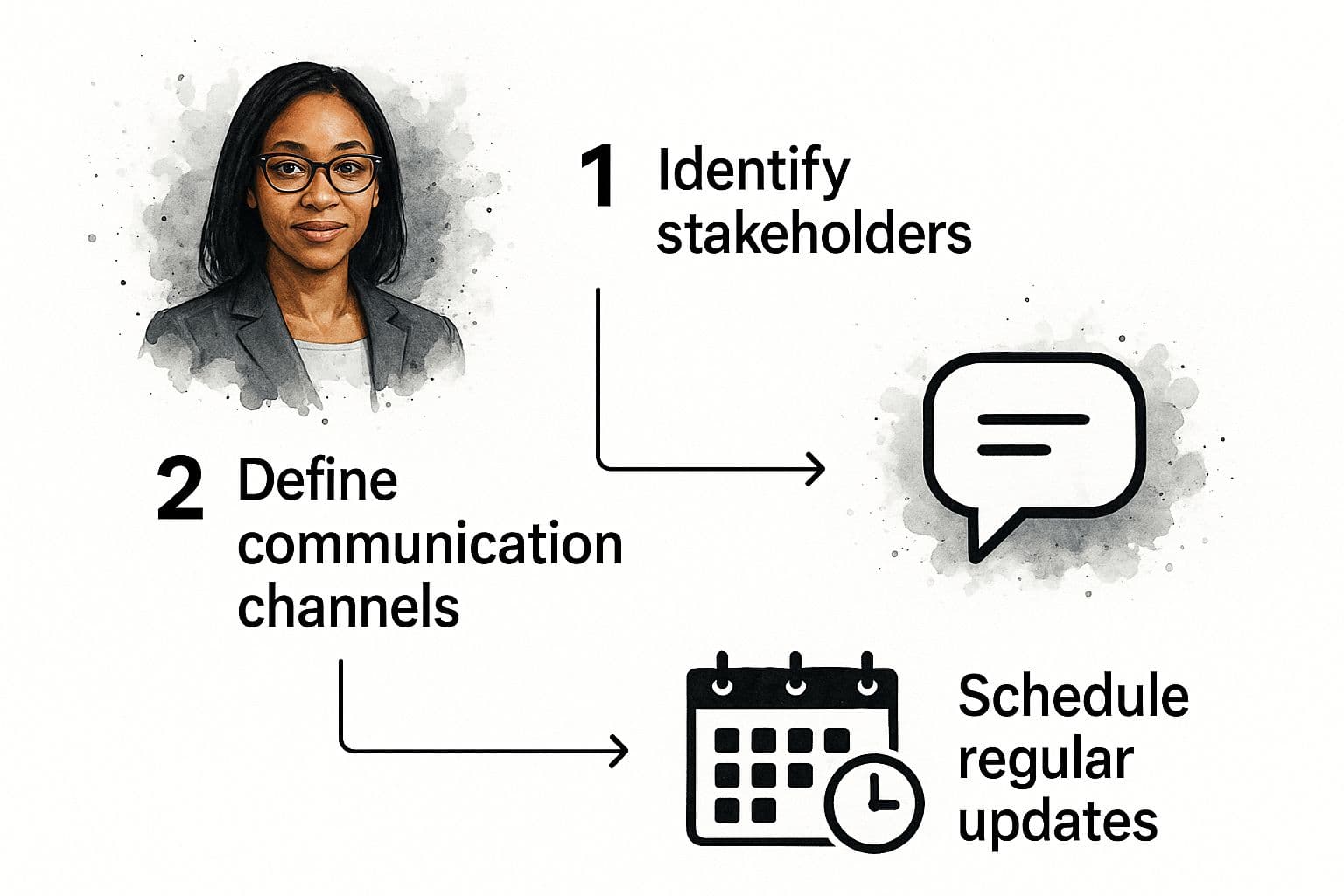Stop project chaos with our free project communications plan template. Learn to build a strategy that keeps stakeholders aligned and your project on track.
June 29, 2025 (6mo ago) — last updated December 25, 2025 (8d ago)
Your Project Communications Plan Template and Guide
Stop project chaos with our free project communications plan template. Learn to build a strategy that keeps stakeholders aligned and your project on track.
← Back to blog
A project communications plan template** is essentially your playbook for who needs to know what, when they need to know it, and how you’re going to tell them. It's the blueprint that keeps your project team, leadership, and external partners all on the same page, heading in the same direction. Without it, you're just hoping for the best.
Why Projects Fail Without a Communication Plan

Let's be real. Most projects don't fail because of a technical glitch or a lack of talent. They fall apart because communication breaks down. When information gets siloed, misinterpreted, or just plain lost, the project slowly grinds to a halt. This is where a formal communication strategy isn't just a "nice-to-have"—it's a necessity.
A project communications plan is your strategic guide for every piece of information that flows in and out of your project. It’s far more than just picking a tool like Slack or deciding to send a weekly email. It’s a deliberate, documented approach that ensures the right messages reach the right people at precisely the right moments. A solid project communications plan template is your first and best defense against this all-too-common cause of project failure.
The Real Cost of Miscommunication
The fallout from poor communication is swift and expensive. When there's no clear plan, a predictable set of problems almost always emerges, chipping away at your budget, timeline, and team spirit.
I’ve seen it happen time and again. The issues usually include:
- Budget Overruns: Teams end up doing the same work twice or fixing mistakes that were entirely preventable. Every avoidable error adds a direct hit to your budget.
- Missed Deadlines: Critical information about a dependency or a roadblock doesn't get shared, and suddenly the whole schedule starts to unravel.
- Plummeting Team Morale: Nothing kills motivation faster than confusion. When people get conflicting instructions or feel like they're always out of the loop, frustration and burnout are right around the corner.
- Disappointed Stakeholders: When clients or executives have no idea what's going on, their confidence craters. They start to doubt not just the project's success, but your team's ability to deliver.
A project without a communication plan is like a ship without a rudder. It might move forward, but its direction is left entirely to chance, often drifting toward the rocks of failure.
How a Template Provides Control
This is where a good template really shines. Instead of starting from scratch with every new project, you have a proven framework that you can adapt in minutes. It’s not just about saving time; it's about building in best practices from the very start.
We have a lot of data that shows structured communication directly impacts success. For example, simply taking the time to properly identify and analyze your stakeholders before you even start communicating can boost project success rates by 35%. A plan that clearly defines roles and responsibilities can slash communication gaps by up to 60%, because everyone knows exactly who to go to for what.
You can learn more about how these structured approaches work by reviewing key insights on project communication planning. By starting with a template, you’re not just being efficient—you’re proactively tackling the most common reasons projects go off the rails.
Before diving into creating your own, it's helpful to understand the key pieces that make up an effective plan. These are the non-negotiable elements that turn a simple document into a powerful project management tool.
Core Components of a Project Communications Plan
| Component | Purpose | Example |
|---|---|---|
| Stakeholder Analysis | Identifies everyone who needs information and what their specific needs are. | Executive team needs a high-level monthly summary; developers need daily stand-ups. |
| Communication Goals | Defines what you want to achieve with your communications. | Goal: Ensure all stakeholders are aware of project status and any risks by Friday each week. |
| Key Messages | The core information that needs to be consistently communicated. | Message: "Phase 1 is on track for a June 30th launch, with a focus on user onboarding." |
| Communication Channels | Specifies the tools and methods to be used for different audiences. | Team Updates: Slack. Stakeholder Reports: Email. Urgent Issues: Phone Call. |
| Frequency & Cadence | Outlines how often communication will occur. | Daily Scrums (15 min), Weekly Progress Reports (Friday EOD), Monthly Steering Committee Meetings. |
| Owner/Point Person | Assigns responsibility for sending each type of communication. | Project Manager owns the weekly stakeholder report; Tech Lead runs daily stand-ups. |
| Feedback Mechanism | Establishes how stakeholders can ask questions or provide input. | Feedback can be submitted via a dedicated Slack channel or during bi-weekly Q&A sessions. |
Having these components clearly defined in your template ensures you cover all your bases and leave nothing to chance. It's the foundation for clear, consistent, and effective project communication.
Laying the Foundation for Your Communications Plan
Once you have a template, the real work begins. This is your chance to shape a generic document into a command center specifically for your project. A great plan is much more than a list of names and dates; it's a living reflection of your project's unique environment, built for the very people who will bring it to life.
Let's use a real-world example: a software development project. You've got your in-house developers, a few remote contractors in different time zones, and a crucial external client who’s funding the whole show. Each of these groups needs a completely different approach. Just listing them out won't cut it. You have to dig into their influence, their interests, and what they really need to know to build a strategy that works.
This infographic breaks down the core process for getting that foundation right.

As you can see, it’s a logical flow. You start by figuring out who you're talking to, then decide what to say and how to deliver it. This is the secret to building a plan people will actually follow.
Get Crystal Clear on Your Communication Goals
Before you start picking channels or booking meetings, you have to know what you're trying to accomplish. A vague goal like "keep everyone informed" is pretty much useless. Instead, you need specific, measurable objectives that tie directly back to your project's success.
For our software project, clear goals might look something like this:
- For the Client: To ensure the client feels confident about project progress and has a clear view of the budget spend, which we'll confirm weekly.
- For the Development Team: To guarantee every developer knows their bi-weekly sprint priorities and feels empowered to flag blockers the moment they arise.
- For Leadership: To provide executives with a high-level summary of risks and milestone achievements on the first business day of each month.
These goals become the "why" behind every single email, report, and meeting. For more insights on this, take a look at our guide on essential project management tips.
Match Stakeholders to the Right Channels
With your goals set, you can now connect them to the right people and the best ways to reach them. This part is more of an art than a science. It's about thinking critically about the message itself and the preferences of your audience.
A classic mistake I see all the time is the one-size-fits-all approach. Sending a deeply technical bug report to your client is just as bad as giving a vague, high-level summary to a developer who needs nitty-gritty details to get their work done.
Your plan needs to spell out these different approaches. This is where using a project communication plan template really shines—it gives you a repeatable framework to customize. By tailoring key messages, like detailed progress updates for clients and specific task info for team members, you get better engagement and drastically lower the risk of things getting lost in translation.
Let's break it down for our software project:
- Client Updates: A formal, written report emailed every Friday, followed by a 30-minute video call on Monday to talk it over.
- Developer Coordination: A dedicated Slack channel for quick, asynchronous updates and a mandatory 15-minute daily stand-up meeting.
- Executive Reports: A clean, one-page PDF uploaded to a shared dashboard, with an automated notification sent straight to their inbox.
Getting this specific is what turns your plan from a theoretical document into a powerful, strategic tool that actively pushes your project toward the finish line.
Customizing Your Template for Any Project Type

A good project communications plan template is a fantastic starting point, but that's all it is—a start. The real magic happens when you mold that template to the unique personality and demands of your project. After all, every project has its own rhythm and its own set of rules.
Think about it. A fast-paced software sprint and a multi-year construction build are worlds apart. One lives on quick, informal huddles, while the other is built on a foundation of formal reports and signed change orders. A generic, one-size-fits-all plan just won't cut it.
Tailoring for Agile vs. Traditional Projects
The project methodology you're using is probably the biggest factor that will shape your communications plan.
If you’re running an Agile project, your plan needs to be all about speed and collaboration. The focus should be on channels that enable those rapid feedback loops.
- Daily Stand-ups: This is the heartbeat of an Agile team. Your plan should lock in the time, attendees, and key purpose of this daily ritual.
- Instant Messaging: For us, tools like Slack or Microsoft Teams are non-negotiable. The key is to define channels for specific topics (e.g.,
#dev-blockers,#design-feedback) to prevent chaos. - Digital Kanban Boards: Visual tools like Trello or Jira are your single source of truth for task status. They communicate progress passively and constantly, without needing a meeting.
On the other hand, a traditional (Waterfall) construction project demands a much more formal, structured approach. Here, documentation isn't just for clarity—it's for accountability and can have legal weight.
- Formal Progress Reports: These are essential. Think weekly or bi-weekly reports detailing budget variance, schedule adherence, and photo documentation of the work completed.
- Scheduled Stakeholder Meetings: These are formal affairs. Agendas are sent in advance, and detailed minutes are captured and distributed afterward.
- Documented Change Orders: Any deviation from the original scope must follow a rigid process. Your plan needs to spell out exactly how changes are requested, reviewed, approved, and communicated.
Your project’s methodology is the single biggest factor influencing its communication needs. An Agile team bogged down by formal reports will lose momentum, while a construction project without rigorous documentation is courting disaster.
Adjusting for Scale and Audience
Beyond methodology, the sheer scale of your project changes everything. Communicating for an internal marketing campaign is a different beast entirely from managing an enterprise-wide system rollout.
For a small internal campaign, keep the plan lean. You might only need to formalize a weekly team check-in and a monthly progress email to your department head. The goal is simple team alignment, not bureaucratic overhead.
When you're dealing with a large enterprise system rollout, your communications plan becomes a critical strategic document. You're juggling the needs of a huge, diverse audience—from C-suite executives who want the 10,000-foot view to end-users who just need to know how their daily job will change.
Before you even start, it's a good idea to map out who needs what. A stakeholder matrix is perfect for this. You can download a free project priority matrix template today to help connect stakeholder needs directly to project goals.
Taking the time for this level of detail ensures you’re not just broadcasting updates into the void. You're strategically engaging with every single person impacted by the project.
Choosing the Right Communication Tools and Channels
Picking the right communication tools for a project is a critical strategic move. It’s about much more than just defaulting to Slack or Microsoft Teams. A truly effective project communications plan template doesn't just list a bunch of apps; it clearly defines the purpose behind each one.
The real goal here is to create a clean, efficient information highway where everyone knows where to find what they need. Without that clarity, you end up with a digital free-for-all where important messages get buried in noise and nobody's quite sure where to look for updates.
The key to getting this right lies in understanding two fundamentally different styles of communication: synchronous and asynchronous. Nailing this balance is the secret to keeping your team both productive and sane.
Synchronous Communication: When You Need Answers Now
Synchronous communication is all about real-time interaction. It's the immediate back-and-forth you get from a video conference, an in-person team huddle, or an urgent phone call. This is your go-to method for brainstorming new ideas, tackling complex problems as a group, or simply building that crucial team chemistry.
You’ll want to lean on synchronous channels for moments like these:
- Kick-off Meetings: Nothing beats a live meeting for getting everyone aligned on project goals and building that initial wave of excitement.
- Daily Stand-ups: These are perfect for quick, daily check-ins to see who's stuck and how the team can help unblock them.
- Urgent Issue Resolution: When a problem pops up that needs immediate, collaborative thinking to stop it from derailing the project, a live conversation is essential.
But here’s the catch: relying too heavily on synchronous methods is a recipe for team burnout. A calendar packed with back-to-back meetings and a constant barrage of notifications obliterates any chance for deep, focused work. It's a growing problem—recent data shows the average employee now navigates 10 planned changes a year, a huge jump from just two a few years back. Each one of those changes can easily spawn more meetings if you aren't careful.
Your team’s most valuable resource is their uninterrupted focus. A well-designed communications plan protects that focus by making meetings a strategic choice, not a default habit.
Asynchronous Communication: For Focus, Thought, and Record-Keeping
Asynchronous communication is the complete opposite—it doesn’t demand an immediate response. We're talking about things like emails, comments within your project management software, and shared documents. This approach respects everyone's schedule and focus, giving people the space to contribute thoughtfully without derailing their entire day.
This is the workhorse for most of your project communications:
- Daily & Weekly Status Updates: A formal status report sent via email allows stakeholders to review progress on their own time. No meeting required.
- Detailed Feedback: Leaving specific comments in a shared Google Doc or a Figma design file provides far more precise feedback than a rushed conversation.
- Permanent Documentation: Using a wiki tool like Confluence or Notion creates a single source of truth for project specs, decisions, and processes that anyone can access, anytime.
For example, on a software project, I might set up a dedicated Slack channel for quick, informal developer chatter and an Asana task for formal design feedback. At the same time, weekly stakeholder updates go out in a templated email, while all core project requirements live on a permanent Confluence page.
This layered approach gives every type of communication a clear home. It cuts through the digital noise and ensures every update lands with purpose. This is exactly the kind of granular detail a great project communications plan template should help you define.
How to Implement and Manage Your Communication Plan

A communication plan is only as good as its execution. You can map out the most brilliant strategy, but if it just sits in a shared drive, it’s worthless. The real work begins when you put that plan into action, get your team on board, and actively manage it from kickoff to closeout.
Don't just email the plan and expect everyone to read it. That never works. Instead, schedule a kickoff meeting specifically to walk your team and key stakeholders through the document. This is your chance to explain the why behind your decisions. Clarify why status reports are weekly, why a specific Slack channel is for urgent issues only, and who is responsible for each update. That upfront transparency is what gets people to actually adopt the plan.
Turn Your Plan Into a Living Document
Here’s a hard truth: projects are messy, and no plan survives first contact with reality. Your communication plan can't be a rigid, set-in-stone document. It has to be a living guide that you adapt as the project unfolds. The trick is to build in a natural rhythm for reviewing and tweaking it.
I learned this lesson on a recent software launch. Our initial plan had bi-weekly demos for stakeholders. But after a month, we got feedback that they felt disconnected and anxious between meetings. So, we adjusted. We switched to quick, informal weekly video updates and saved the polished demos for major milestones. That small change made a huge difference in their confidence and cut down on the "just checking in" emails.
Your communication plan should be a compass, not a rigid map. It provides direction, but you have to be willing to adjust your course based on the terrain you actually encounter.
Schedule Regular Health Checks
To keep your plan from going stale, you need to check its pulse regularly. This doesn't mean adding another pointless meeting to the calendar. It’s about creating intentional moments to pause and ask, "Is this still working for us?"
Here’s a simple framework I use:
- At Project Milestones: The end of a sprint or a major phase is the perfect time to reflect. Did our communication flow help or hinder the work we just finished?
- When Big Changes Happen: Did you get a new executive sponsor? Did the scope of the project suddenly expand? Any major shift should trigger a quick review of the plan to see what needs updating.
- On a Set Cadence: For projects that stretch over many months, a simple quarterly check-in can uncover communication gaps before they become real problems.
Many of today's project management platforms are built to support this kind of agile approach. The rise of project communication plan templates has been driven by tools that understand their importance. Many even offer free templates for things like stakeholder maps and communication schedules that can guide your team through the process.
Troubleshooting Common Roadblocks
Even with a great plan, things will go sideways. Stakeholders will go rogue and use DMs for critical decisions, or information will somehow get lost in transit. The key is to anticipate these common issues so you can steer things back on course quickly.
- Problem: A key stakeholder keeps making important decisions in private messages.
- Solution: Gently, but publicly, redirect them. A simple, "Great point! Can you post that in the #Project-Decisions channel so the whole team has visibility?" works wonders. It reinforces the process without making anyone feel called out.
- Problem: The team is complaining about "meeting fatigue."
- Solution: Take a hard look at your calendar. Is every meeting truly necessary? Could that 30-minute status update be a concise email instead? Ask the team for their feedback and, most importantly, act on it.
- Problem: The right information isn't reaching the right people.
- Solution: Go back to your stakeholder analysis. Did someone get left off a distribution list? Is the format you chose—like a dense report—not working for a visual-minded executive? Consistently tracking project progress will help you spot these gaps before they cause damage.
Questions We Hear All the Time About Communication Plans
Even with a perfect template in hand, you’re bound to run into some practical questions once a project gets rolling. It happens on every project. Let’s tackle some of the most common things project managers ask when they start putting their communication plan into action.
How Often Should I Update My Plan?
Your communication plan should be a living document, not a "set it and forget it" file. It needs to adapt as your project moves forward.
I always recommend reviewing it at key project milestones—think the end of a design phase or after a major development sprint. You absolutely have to revisit it whenever something big changes. For instance, if a new executive stakeholder joins the team, the scope gets a major overhaul, or you hear feedback that the weekly emails just aren't cutting it.
For longer projects, setting a recurring quarterly review is a smart way to make sure the plan doesn't go stale.
What’s the Difference Between a Stakeholder Register and a Communications Plan?
This is a great question because they're closely related, but they do very different jobs.
Think of the stakeholder register as your cast of characters. It’s the foundational list of everyone who has a stake in the project. You use it to analyze their interest, influence, and what they expect to happen. It's all about the "who" and it's a critical input for your communication plan.
The communications plan, on the other hand, is the script. It's the strategic document that spells out the how, what, when, and why of your communication with all those people from the register. It’s your action plan, detailing the specific messages, channels, frequency, and owners for everything you send out.
A stakeholder register tells you who is in the audience; the communications plan is the script that tells you what to say to them and how to say it.
How Do I Get My Team to Actually Follow the Plan?
The secret here isn't about enforcing rules; it's about getting buy-in from the start. Don't just create the plan in a vacuum and hand it down.
Bring your team into the process. Hold a quick workshop and ask them what channels and timing work best for different kinds of updates. When people help build the plan, they're much more likely to follow it.
Also, be sure to explain the "why." Frame it as a way to reduce pointless meetings, clarify who’s doing what, and make everyone’s job easier. Most importantly, you have to lead by example. If a key decision pops up in a direct message, gently guide the conversation back to the right place. A simple, "Great point! Can you post that in the main project channel so everyone has visibility?" works wonders. It reinforces the process without making you feel like the communication police.
Ready to stop juggling chaotic tasks and start building a focused workflow? Fluidwave combines smart task management with on-demand virtual assistants to help you conquer your to-do list. Delegate tasks, automate your processes, and find your flow. Get started with Fluidwave for free today.
REQUIREMENTS:
- Remove each broken blog link completely (both the markdown link syntax and the descriptive text)
- Rewrite sentences naturally after removing references
- Preserve all other markdown formatting
- Only remove references to the specific broken blog links, don't change other content
- Process all broken URLs in a single pass
Example: Before: "...for your small business as described in the small business article." After: "...for your small business."
Please return your response in the following JSON format: { "updatedContent": "the full content with all broken links removed", "removals": [ { "brokenUrl": "the broken blog URL", "explanation": "brief explanation of what was removed and how the text was adjusted" } ] }
Focus on What Matters.
Experience lightning-fast task management with AI-powered workflows. Our automation helps busy professionals save 4+ hours weekly.